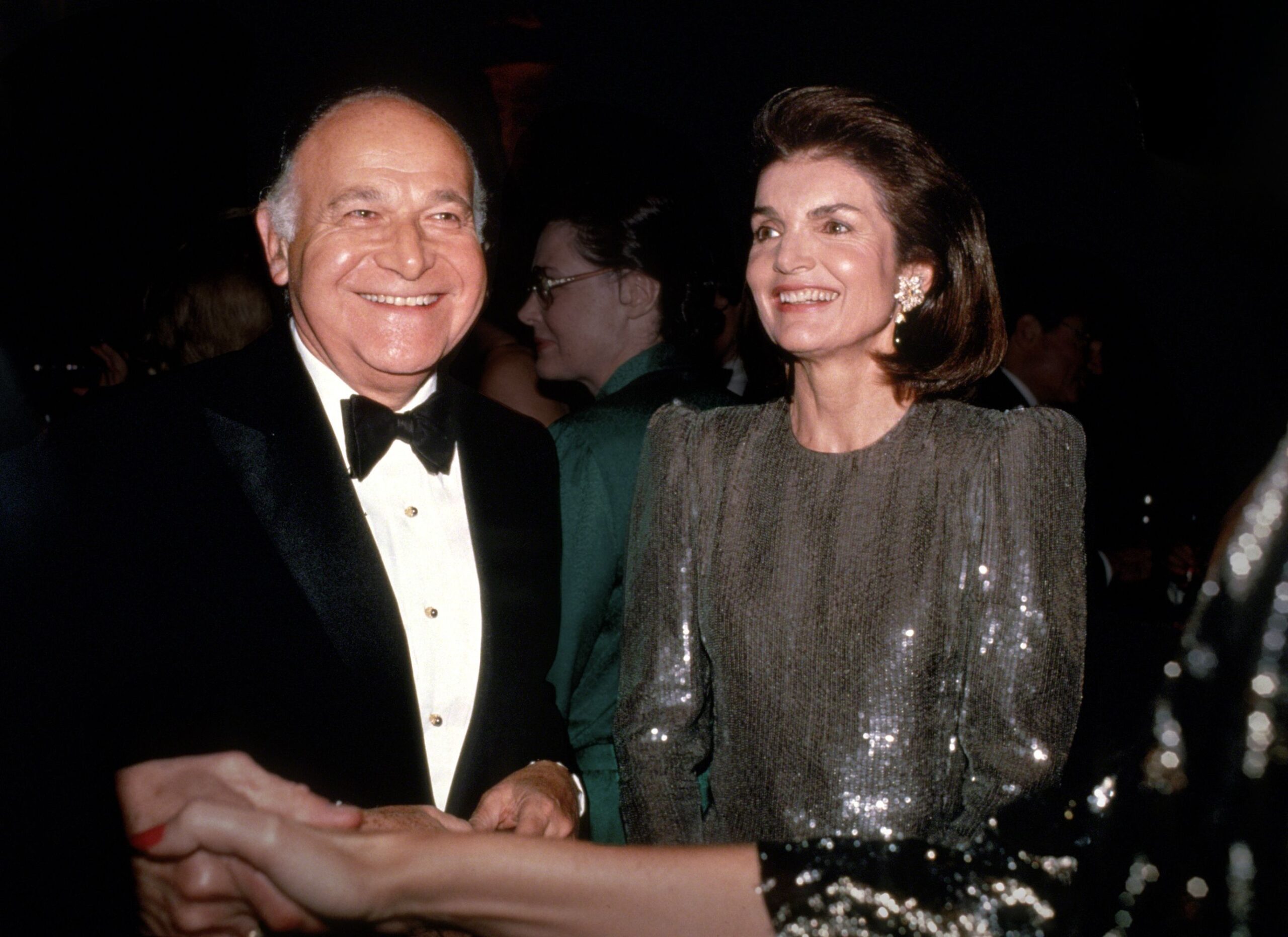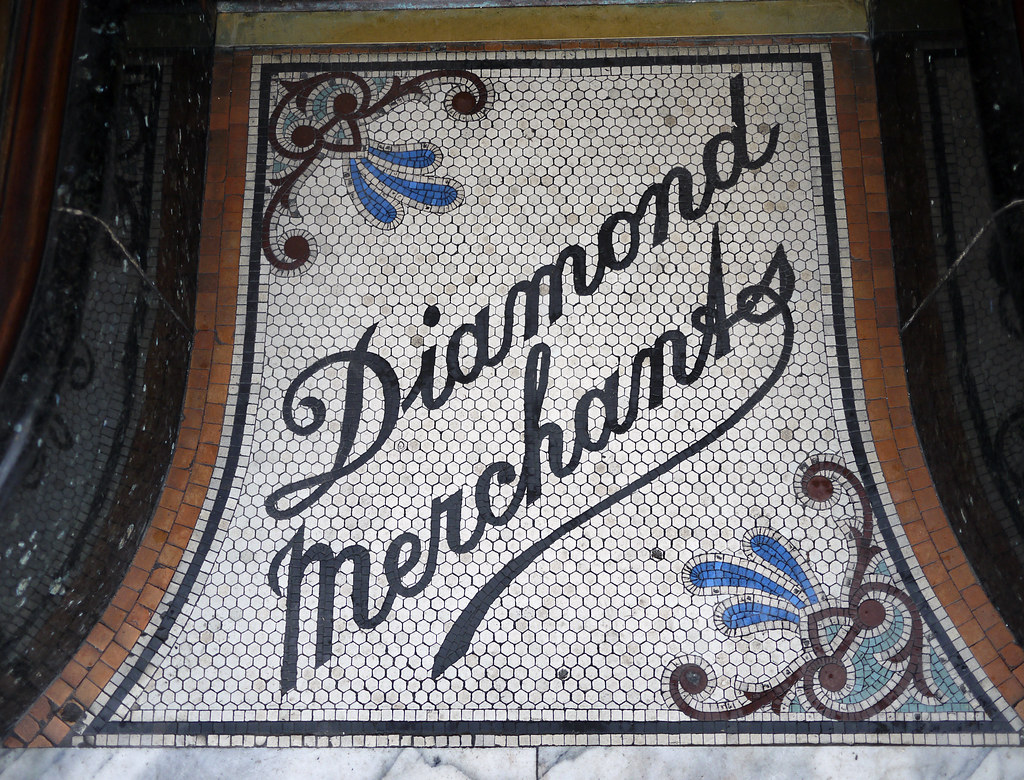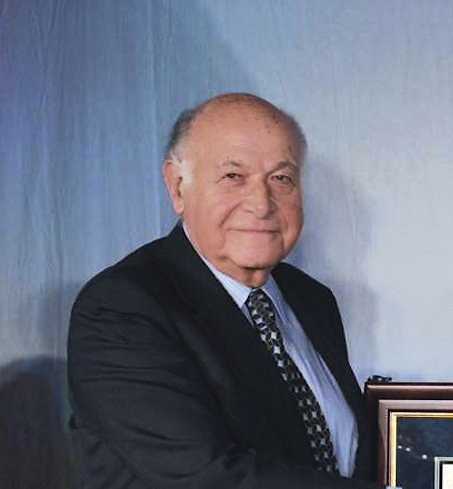
Maurice Tempelsman, a figure of profound influence in the global diamond industry and a significant presence in American political and philanthropic circles, passed away on Saturday in Manhattan at the age of 95. His death, stemming from complications of a fall, marks the end of an extraordinary life that seamlessly blended the often-secretive world of gem commerce with high-profile personal relationships and international diplomacy. Throughout his decades-long career, Mr. Tempelsman remained an intensely private individual, yet his actions and associations frequently placed him at the nexus of power and public curiosity.
For many years, the general public primarily recognized Mr. Tempelsman as the devoted final companion of Jacqueline Kennedy Onassis, a role that brought him an unexpected measure of public scrutiny in the late 1980s and early 1990s. However, behind this widely known personal connection lay a much broader narrative of a self-made magnate whose foresight, ambition, and strategic acumen reshaped the landscape of African resource extraction and American political fundraising. His story is one of resilience, quiet influence, and an unwavering commitment to his varied interests, from the intricate dance of international trade to the discreet support of global health initiatives.
This article will delve into the multifaceted life of Maurice Tempelsman, exploring the pivotal moments and defining relationships that forged his unique path. We will examine his early struggles as a refugee, his swift ascent in the diamond business, his controversial yet impactful engagements in newly independent African nations, and the quiet but profound connections he cultivated with some of the 20th century’s most iconic figures. His journey offers a compelling study of ambition, discretion, and the often-unseen forces that shape global affairs.

1. **A Life Forged in Flight: Maurice Tempelsman’s Early Years and Escape from Nazi Occupation**Maurice Tempelsman’s life began on August 26, 1929, in Antwerp, Belgium, a city then synonymous with the international diamond trade. He was born to Leon and Helen (Ertag) Tempelsman, within an Orthodox Jewish family deeply rooted in the commodities business. This early environment undoubtedly provided him with an intrinsic understanding of global commerce, setting the stage for his future endeavors.
The tranquil beginnings of his childhood were abruptly shattered by the onset of World War II. In 1940, as Nazi Germany invaded Belgium, the Tempelsman family was forced to make a harrowing escape from their homeland. This displacement was a formative experience, instilling in young Maurice a deep sense of resilience and a keen awareness of geopolitical shifts and their personal consequences.
The family, along with other refugees from Antwerp, eventually found refuge in the United States, settling on the Upper West Side of Manhattan. This transition from a war-torn continent to a new life in New York City laid the groundwork for his American identity while retaining a global perspective shaped by his European roots.

2. **From Academia to Gemstones: Launching Leon Tempelsman & Son**Maurice Tempelsman’s educational journey at New York University was notably brief, spanning just two years before he made the pivotal decision to depart from academia. This choice reflected an inherent drive and a clear vision for his future, one that lay not in traditional collegiate pursuits but in the dynamic world of business. His father, Leon Tempelsman, concurrently embarked on a new business venture, establishing themselves as diamond merchants.
It was into this nascent family enterprise, named Leon Tempelsman & Son, that Maurice plunged with youthful vigor and an emerging entrepreneurial spirit. The firm’s foundation marked the true genesis of his storied career in the diamond industry, an arena where he would soon distinguish himself with an uncommon blend of ambition and strategic acumen. This early collaboration with his father provided a crucial apprenticeship, allowing him to absorb the intricacies of the trade directly.
His decision to leave university and join the family business so early in his life underscores a readiness to embrace practical experience and seize immediate opportunities. This hands-on approach, rather than a prolonged academic path, became a defining characteristic of his rise. It was in the daily dealings of Leon Tempelsman & Son that he began to hone the negotiating skills and international understanding that would become hallmarks of his professional life.

3. **A Strategic Stroke: Securing the U.S. Government Diamond Stockpile**At a remarkably young age, barely into his twenties, Maurice Tempelsman demonstrated an extraordinary knack for high-stakes business dealings. In 1950, he achieved a monumental success for his fledgling firm, Leon Tempelsman & Son, by persuading the United States government to engage in a substantial acquisition of African industrial diamonds. This was no ordinary commercial transaction; it was a strategically vital procurement for the nation’s stockpile of materials, maintained specifically for national emergencies.
This audacious move positioned Mr. Tempelsman as a crucial middleman in a critical global supply chain. He orchestrated the buying of these essential diamonds directly from African suppliers, generating millions of dollars for his family’s company. The success of this endeavor not only solidified the firm’s financial footing but also established Mr. Tempelsman’s reputation as a resourceful and influential operator in the international commodities market, capable of navigating complex governmental needs.
Furthermore, his role extended beyond industrial diamonds. He acted as a vital go-between in intricate deals, facilitating the delivery of other strategic materials such as cobalt and uranium to the United States. In exchange, he secured agricultural commodities, which he then adeptly sold for further profit. This multi-faceted approach showcased his early understanding of global trade imbalances and his ability to leverage diverse resources for mutual benefit.

4. **Seizing the Future: Vision in a Decolonizing Africa**Maurice Tempelsman possessed a remarkable foresight that allowed him to perceive the profound implications of a rapidly changing global landscape. He keenly understood that the sweeping tide of decolonization across Africa would inevitably loosen the firm grip that traditional colonial companies had long held over the continent’s vast and valuable natural resources. This geopolitical shift, he correctly surmised, would not merely alter existing power dynamics but would also unveil unprecedented opportunities for astute and energetic outsiders like himself.
His strategic vision was rooted in recognizing that the dismantling of colonial empires would create new commercial vacuums and a need for new partners in emerging nations. Where many might have seen instability, Tempelsman identified an opening for innovative engagement. He saw independent African nations as potential new markets and sources, eager to assert economic sovereignty and seeking direct access to international markets for their raw materials.
This understanding spurred him to cultivate relationships and establish a presence in these newly self-governing territories, positioning his firm to capitalize on the evolving economic landscape. His approach was a calculated gamble, anticipating that direct engagement with local leaders, rather than through entrenched colonial intermediaries, would be the key to unlocking the continent’s immense mineral wealth. It was a bold move that would define much of his subsequent career.
.jpg/844px-25_pesewas_(1958).jpg)
5. **Ghanaian Ventures and Political Tides: The Nkrumah Era**At the age of 27, demonstrating his characteristic blend of ambition and strategic networking, Maurice Tempelsman embarked on a significant venture into West Africa. Accompanied by his lawyer, Adlai E. Stevenson II, who was a former two-time Democratic presidential nominee and a prominent figure, Tempelsman traveled to the Gold Coast. This region was then undergoing a transformative period, with local diamond diggers having established their own burgeoning market.
Tempelsman quickly secured one of the first buying licenses in this newly independent nation, which soon became Ghana. For a period, he became an integral part of a flourishing diamond trade within the country, actively participating in and profiting from its rich resources. This early success underscored his ability to identify and penetrate new markets, building commercial relationships in a rapidly evolving political environment.
However, his involvement in Ghana also illustrates the complex intersection of business and politics that would characterize much of his career. According to declassified Kennedy administration documents cited by Insight magazine, when Ghana’s nationalist leader Kwame Nkrumah began implementing socialist economic policies that threatened the established diamond market, Mr. Tempelsman’s representatives took a leading role. They actively pressed for Nkrumah’s removal, advocating for the installation of a Western- and business-friendly rival. Nkrumah, whose rule grew increasingly erratic, was ultimately deposed in a 1966 military coup, a controversial outcome reflecting the significant influence wielded by external commercial interests.

6. **Forging Alliances in Zaire: The Mobutu Concession**Maurice Tempelsman’s strategic gaze extended beyond Ghana to the vast mineral riches of Congo, a nation abundantly endowed with diamonds and copper. Recognizing the immense potential, he became an ardent early supporter of Colonel Joseph Mobutu, who would later emerge as the autocratic leader of what became Zaire. This alliance was a pivotal moment in Tempelsman’s African ventures, demonstrating his willingness to align with powerful, albeit controversial, figures to secure business interests.
He was notably credited with playing a crucial role in smoothing the path for Western backing of Mobutu, a leader whose rule would later be characterized by corruption and repression. This strategic support paid significant dividends for Tempelsman’s firm. In a particularly lucrative deal, Mr. Mobutu awarded the highly coveted copper and cobalt concession at the immense Tenke Fungurume mine directly to Mr. Tempelsman, bypassing a Belgian group to whom it had initially been promised.
While this decision proved a major commercial victory at the time, securing access to one of the world’s richest mineral deposits, it also drew considerable criticism as Mobutu’s leadership deteriorated into widespread corruption and repression. What once appeared to be a politically astute business decision came under withering rebuke in later years. Reflecting on this controversial alliance, Mr. Tempelsman famously remarked to Insight, “Somebody had to win, and I guess we won that one. I wish now we hadn’t!” This statement encapsulated the complex moral landscape of operating in politically volatile regions.

7. **Cultivating Influence: Deep Ties to Democratic Power**Maurice Tempelsman’s professional life was inextricably linked with the corridors of political power, particularly within the Democratic Party. For half a century, he distinguished himself as a prominent and tireless fund-raiser for the party, demonstrating a profound understanding of how political connections could intersect with his extensive business interests. This sustained engagement cultivated enduring relationships with key figures in American governance.
Among his most significant political ties were those forged with Presidents John F. Kennedy and Bill Clinton, relationships that evolved into particular closeness. His association with the Kennedy family, for instance, began in the late 1950s. At that time, Kennedy, then a U.S. senator from Massachusetts with burgeoning presidential ambitions, sought to meet representatives from the South African diamond industry. Mr. Tempelsman, who had already established a formidable reputation for his African mining interests and was close to leading Democrats like Adlai E. Stevenson II, deftly arranged this crucial gathering for Kennedy.
Further solidifying his influence, Mr. Tempelsman later organized a pivotal meeting at the Carlyle Hotel in Manhattan. This was between President-elect Kennedy and Harry Oppenheimer, the chairman of the Anglo American Corporation and De Beers, the world’s largest miners and distributors of diamonds and gold. Such high-level introductions underscored Tempelsman’s unique position as a trusted intermediary, bridging the worlds of international commerce and American political leadership. These connections were not merely transactional but represented a deep, long-standing commitment to the Democratic Party and its vision.

8. **The Reconnection with Jacqueline Kennedy Onassis: A Partnership Forged in Trust**Maurice Tempelsman’s path intersected with Jacqueline Kennedy Onassis over many years, a connection that deepened profoundly following the death of her second husband, the Greek shipping tycoon Aristotle Onassis, in 1975. It was in this period of personal transition for Mrs. Onassis that Mr. Tempelsman stepped into a crucial role, becoming her financial adviser. His acumen in the world of global finance soon yielded significant results, with reports indicating he successfully quadrupled her $26 million inheritance from Mr. Onassis.
This professional relationship quickly evolved, laying the groundwork for a deeply personal bond that would define the final decades of Mrs. Onassis’s life. Within a few years of his advisory role, Mr. Tempelsman and Mrs. Onassis began to be seen together frequently, not just in business settings but at private dinners, consular affairs, and cultural events such as the ballet and the opera. Their public appearances signaled the emergence of a new companionship, though its private dimensions remained largely shielded from public view.
Their shared experiences and burgeoning trust formed the bedrock of a relationship that was both discreet and profound. Mr. Tempelsman’s guidance in managing Mrs. Onassis’s substantial inheritance underscored his business capabilities and earned him an unparalleled level of confidence. This financial partnership ultimately blossomed into a romantic one, marking a significant chapter for both individuals as they navigated a life together that balanced public visibility with an unwavering commitment to privacy.

9. **An Urbane and Reserved Alliance: The Qualities that Drew Them Together**To some outside observers, the pairing of the slim and elegant Mrs. Onassis with the portly and balding Mr. Tempelsman may have initially appeared as another unlikely match, following her previous marriage to a man 23 years her senior. However, those intimately familiar with both Jacqueline Kennedy Onassis and Maurice Tempelsman consistently highlighted the profound, shared qualities that drew them together and sustained their relationship with remarkable depth.
Mr. Tempelsman possessed a demeanor much akin to Mrs. Onassis’s own; he was urbane, reserved, and held discretion among the highest virtues. Beyond their shared appreciation for privacy, he exhibited a sharp wit, a gentle and unassuming manner, and a deep respect for scholarship and learning. His abiding interest in the arts resonated deeply with Mrs. Onassis, as did his extensive knowledge of Africa, a continent that had captivated him throughout his business career.
Crucially, they were also the same age, a factor that contributed to a sense of parity and shared understanding. These attributes painted a picture of a companion who was not only a shrewd financial mind but also an intellectual and cultural equal, capable of engaging her on many levels. Their connection, therefore, transcended superficial appearances, rooted instead in a mutual respect for intellect, culture, and a shared desire for a life of quiet dignity away from the incessant glare of public life.

10. **Navigating Public Life with Dignity: Shared Joys and Enduring Privacy**For years, Maurice Tempelsman meticulously endeavored to discourage photographers eager to capture images of him alongside Jacqueline Kennedy Onassis, steadfastly maintaining their desire for privacy. Despite the intense public fascination with Mrs. Onassis, particularly in New York’s vigilant gossip circles, there was a remarkable absence of negative commentary or disapproval regarding their relationship. This stemmed from an unspoken consensus that had emerged around Mrs. Onassis, largely due to the extraordinary dignity she exhibited in the aftermath of President Kennedy’s assassination in 1963, granting her an entitlement to personal happiness and privacy.
Their shared life in New York was marked by understated elegance and cherished routines. They frequently entertained friends for dinner within the intimacy of their homes and relished visits to small, discreet restaurants on the Upper East Side. A particularly enduring image of their companionship involved their walks in Central Park, during which they often enjoyed conversing in French, adding a layer of personal enjoyment and intellectual connection to their daily lives.
Beyond the city, their romance flourished in more serene settings. Weekends were spent at Mrs. Onassis’s horse farm in New Jersey, while summers offered respite at her oceanfront estate on Martha’s Vineyard. They often sailed aboard Mr. Tempelsman’s yacht, the Relemar, a vessel that once hosted President Bill Clinton and his wife, Hillary Clinton, in 1993, highlighting the continued intersection of Mr. Tempelsman’s political influence with his personal life, all while upholding the discreet charm that defined their relationship.

11. **Unwavering Devotion Through Her Final Years and a Poetic Farewell**The depth of Maurice Tempelsman’s devotion to Jacqueline Kennedy Onassis was most poignantly demonstrated during the final, challenging chapter of her life. In the winter of 1993, when Mrs. Onassis received the devastating diagnosis of lymphatic cancer, Mr. Tempelsman’s commitment became absolute. He immediately relocated his office into her Fifth Avenue apartment, a move that allowed him to remain by her side, offering constant support and managing affairs with unwavering presence.
Throughout her illness, he was her steadfast companion, meticulously escorting her to and from the hospital, providing a reassuring presence during an immensely difficult period. This level of care and proximity underscored the profound bond they shared, illustrating a partnership that transcended the everyday to confront life’s gravest challenges with shared strength and tenderness. His unwavering support continued until the very end.
Mr. Tempelsman was at Mrs. Onassis’s bedside when she passed away at the age of 64 in May 1994. He then stood with her children at her funeral at the Church of St. Ignatius Loyola on Park Avenue, a somber testament to his integral role in their family. In a deeply moving gesture, he delivered a eulogy, reading from C.P. Cavafy’s poem “Ithaka,” a piece he selected for its profound themes of discovery and life’s journey, offering a poignant reflection on Mrs. Onassis’s remarkable life and their shared path. Roger Wilkins, a journalist, historian, and civil rights champion who knew Mr. Tempelsman for years, later affirmed, “For those of us who cared about Mrs. Onassis, it was comforting — it was terrific — to know she was with somebody who was a good, generous and gentle man,” encapsulating the consensus regarding his quiet strength and supportive nature.
Read more about: Beyond the Grave: Sharon Osbourne Reveals Ozzy’s Secret Legacy Amidst Privacy Outrage – A Look at the Prince of Darkness’s Final Journey

12. **Entrepreneurial Leadership: Steering Lazare Kaplan International and Diversification**In 1984, Maurice Tempelsman took on a significant leadership role, becoming the chief executive of Lazare Kaplan International, a prominent New York-based company. Under his direction, the firm specialized in the import, cutting, and sale of diamonds, catering to an elite clientele that included renowned luxury brands such as Tiffany’s and Cartier. This position placed him at the helm of a key player in the high-end diamond market, further solidifying his reputation as a formidable figure in the global gem industry.
Beyond his leadership at Lazare Kaplan, Mr. Tempelsman remained a general partner in Leon Tempelsman & Son. This family enterprise, which he had joined decades earlier, evolved significantly under his influence, diversifying far beyond its initial focus on diamonds. The company expanded its operations to encompass a broader range of activities including mining, various industrial ventures, and agriculture. This strategic diversification showcased his vision for a multifaceted business empire, capable of navigating different sectors of the global economy.
His entrepreneurial acumen extended to the formation of consortiums specifically designed to mine diamonds and other valuable minerals. This approach allowed his firm to engage in large-scale resource extraction, pooling resources and expertise to undertake ambitious projects across the globe. These strategic moves underscored his continued drive for growth and influence, demonstrating a relentless pursuit of new opportunities and a masterful ability to orchestrate complex commercial endeavors on an international scale.

13. **The Exclusive Circle of Sightholders: Command in the Global Diamond Supply**Maurice Tempelsman held a distinct and powerful position within the global diamond industry as one of only 160 individuals worldwide recognized as a diamond sightholder. This status granted him entry into an extraordinarily exclusive club, distinguishing him as a pivotal figure in the controlled distribution of the world’s most coveted gems. The sightholder system is central to the operations of the De Beers cartel, which has historically maintained a near-monopoly on the global diamond supply.
As a sightholder, Mr. Tempelsman had the unique privilege of buying rough diamonds directly from De Beers several times a year. These highly anticipated events, known as “sights,” involve sightholders receiving a box of diamonds, the contents of which are determined solely by De Beers, with little room for negotiation. This direct access to the primary source of diamonds was not merely a commercial advantage but a testament to his standing, trust, and long-standing relationship within the highly secretive and tightly controlled diamond cartel.
This exclusive arrangement underscored Mr. Tempelsman’s unparalleled influence and access within the secretive world of gem commerce. It enabled his companies, including Lazare Kaplan International and Leon Tempelsman & Son, to consistently acquire high-quality rough stones directly from the source, securing their position at the apex of the diamond value chain. His role as a sightholder exemplified the blend of strategic networking and commercial power that defined much of his remarkable career, reinforcing his status as a true magnate in the industry.

14. **Championing Africa: Development, Liberation, and Enduring Relationships**Beyond the often-criticized aspects of his early African ventures, Maurice Tempelsman also dedicated considerable efforts to fostering the continent’s development and supporting its liberation movements. He chaired influential organizations such as the Africa America Institute and the Corporate Council on Africa, both established with the explicit mission of promoting African growth and strengthening its ties with the Western world. These roles provided him a platform to engage with African leaders across the entire political spectrum, from established governments to emerging liberation activists.
Through these institutions, Mr. Tempelsman maintained deeply entrenched personal and business relationships at the pinnacle of African power, navigating interactions with both right-wing and Marxist governments. His nuanced understanding of the continent’s complex political landscape allowed him to remain a leading Western voice involved in African affairs, demonstrating a long-term commitment that transcended mere commercial interest to include broader developmental goals.
Perhaps one of his most notable contributions to African liberation was his support for Nelson Mandela. In 1990, just months after Mandela’s release from 27 years of imprisonment by the racist apartheid government in South Africa, Mr. Tempelsman played a crucial role by helping to underwrite Mandela’s first historic visit to the United States. This act highlighted his personal commitment to justice and human rights, aligning his influential networks with the cause of anti-apartheid, and showcasing a different facet of his engagement with the continent.
15. **A Legacy of Philanthropy and Global Health Initiatives**In his later years, Maurice Tempelsman’s extensive networks and considerable resources were increasingly channeled toward significant philanthropic endeavors, notably in the realm of global public health. While he had long been active in Jewish philanthropies, his focus broadened to address critical international challenges, demonstrating a profound sense of responsibility beyond the commercial sphere.
He became the chairman of the international advisory council of the Harvard AIDS Institute, a prestigious public health program dedicated to combating the AIDS epidemic. In this capacity, Mr. Tempelsman marshaled the same strategic vision and networking prowess that had defined his business career. He tirelessly worked to connect politicians, leading scientists, and various stakeholders, creating a powerful synergy to strengthen research efforts aimed at ending the AIDS epidemic, particularly across Africa.
His approach to philanthropy was distinctly pragmatic, reflecting his business philosophy. He understood that complex global challenges required collaborative solutions, stating to The Times, “The important thing is to mobilize the different parties that can make contributions. Each of them lives in a different universe.” This quote encapsulates his belief in bringing disparate entities together to achieve a common, impactful goal. Maurice Tempelsman’s legacy, therefore, is not only etched in the annals of global finance and political influence but also in his significant contributions to humanitarian causes, leaving a lasting impact on the fight against one of the world’s most devastating diseases.
Read more about: The Unstoppable Crossover: How Taylor Swift & Travis Kelce are Rewriting the Playbook for NFL, Pop Music, and Modern Celebrity Culture
Maurice Tempelsman’s passing at 95 marks the end of an extraordinary life that wove together the intricate threads of global commerce, high-stakes diplomacy, and deeply personal relationships. From his humble beginnings as a refugee fleeing wartime Europe to his ascent as a diamond magnate and his role as Jacqueline Kennedy Onassis’s devoted companion, his journey was defined by a unique blend of ambition, discretion, and an unwavering commitment to his varied interests. His quiet influence, which stretched from African resource extraction to American political fundraising and crucial global health initiatives, ensures his place as a figure whose impact resonated far beyond the public eye, leaving an indelible mark on the 20th and early 21st centuries.” , “_words_section2”: “1945




